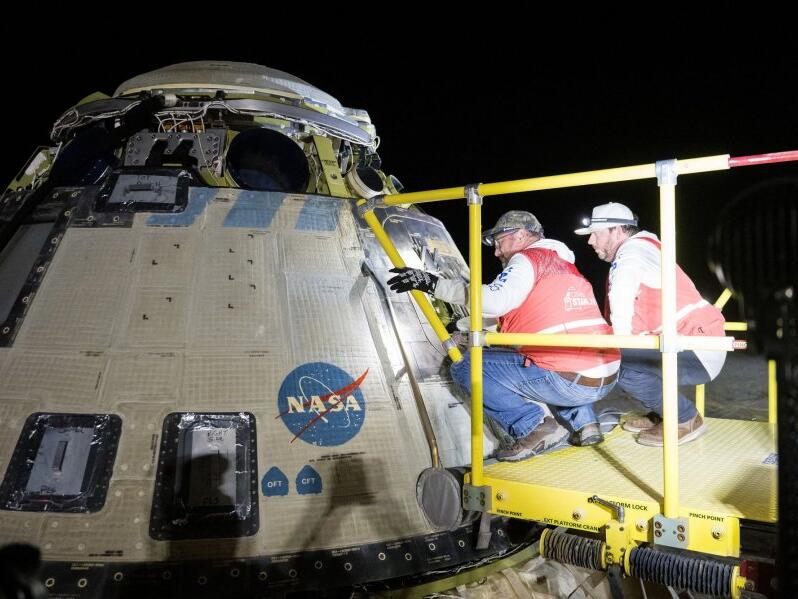Physical Address
304 North Cardinal St.
Dorchester Center, MA 02124
Physical Address
304 North Cardinal St.
Dorchester Center, MA 02124

On September 6, the uncrewed Boeing Starliner made a successful landing in New Mexico after departing from the International Space Station (ISS) just six hours prior. The capsule touched down at White Sands Space Harbor at 10:01 p.m. MDT.
While the Starliner returned safely, two astronauts, Butch Wilmore and Suni Williams, remain aboard the ISS until February, when they will catch a ride home on a SpaceX capsule. NASA opted against sending them back on Starliner due to complications with its thrusters and helium leaks, which made a crewed return too risky.
Ground crews were on standby to retrieve the capsule, which had launched on June 6. The Starliner’s autonomous undocking occurred at 4:04 p.m. MDT, following its release from the forward module of the ISS. It then executed a series of 12 “breakout burns” that gradually moved it away from the station.
As the Starliner entered the Earth’s atmosphere, it was still traveling at speeds exceeding 17,000 miles per hour. The atmosphere around it reached more than 3,000 degrees Fahrenheit, a crucial moment in the spacecraft’s designed reentry sequence.
To slow its descent, three parachutes were deployed in conjunction with thrusters, and airbags also inflated upon landing. Boeing’s continued efforts aim for certification for further NASA missions, as the agency seeks alternatives to SpaceX and Russia’s Soyuz for trips to the ISS.
Remarkably, Starliner is the first U.S.-made spacecraft designed to land on the ground rather than in the ocean, marking a significant achievement in space travel technology.
“It’s important to remember this was a test mission,” said Joel Montalbano, NASA’s deputy associate administrator for space operations, during a post-landing conference.
After its landing, Mark Nappi, vice president and program manager of Boeing’s Commercial Crew Program, congratulated the teams involved in the mission. “I want to recognize the work the Starliner teams did to ensure a successful and safe undocking, deorbit, reentry and landing,” he said. An evaluation of the flight data will help determine the program’s next steps.
Nasa has indicated that while the propulsion system appeared stable, problems with the thrusters made it imprudent to carry human passengers back to Earth on Starliner.
“Having the proper data is crucial for making informed decisions. If we had predicted the results perfectly, we might have considered a crewed flight,” explained an official. “But we do not have that certainty. Although we celebrate the successful landing, it was not the mission we had envisioned with the crew on board.”
The Starliner’s flight path offered an opportunity for observers in northern Mexico and southwestern New Mexico to view its descent across the night sky, depending on visibility conditions.
On June 5, the Starliner launched on its first crewed flight mission, transporting Wilmore and Williams to the ISS. However, the mission took a difficult turn when issues involving helium leaks and malfunctioning thrusters arose as the spacecraft approached the station.
During its journey, five out of 28 reaction control thrusters failed, with only four becoming operational again after the initial malfunction. NASA made the decision to keep Wilmore and Williams aboard the ISS until February, prioritizing their safety as Starliner returned autonomously.
Upon their eventual return, Wilmore and Williams will travel back to Earth aboard a SpaceX Dragon spacecraft as part of NASA’s SpaceX Crew-9 mission. “It is time to bring Calypso home,” said Williams to mission control, showcasing optimism about their spacecraft’s future.
During reentry, the Starliner deployed its service module over the southern Pacific Ocean, and its heat shield was discarded at around 30,000 feet, paving the way for the deployment of braking systems and parachutes.
This latest flight poses yet another challenge for Boeing’s Starliner program, which has already faced significant budget overruns and delays, totaling over $1.5 billion. An uncrewed test flight required by NASA also had to be repeated in 2022 due to complications prior to its initial launch.
Source: UPI



